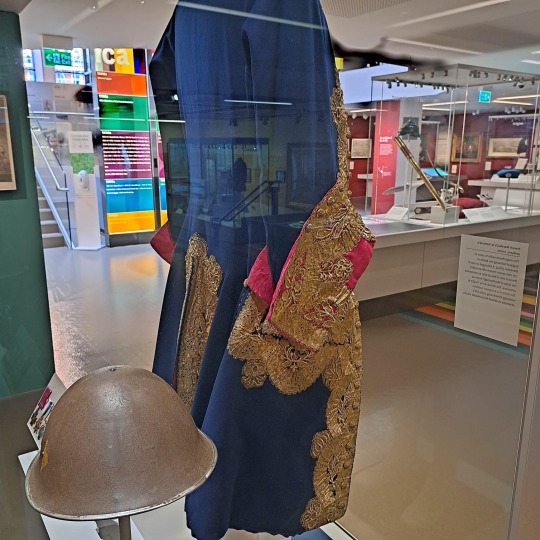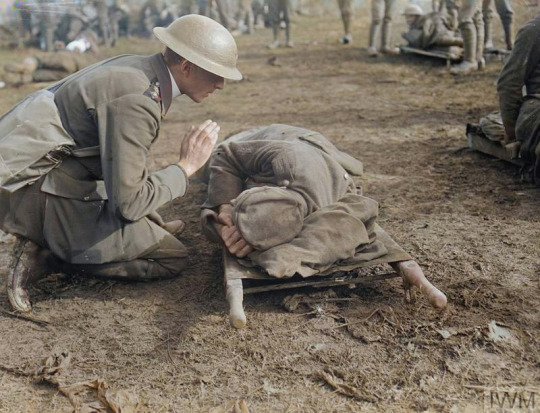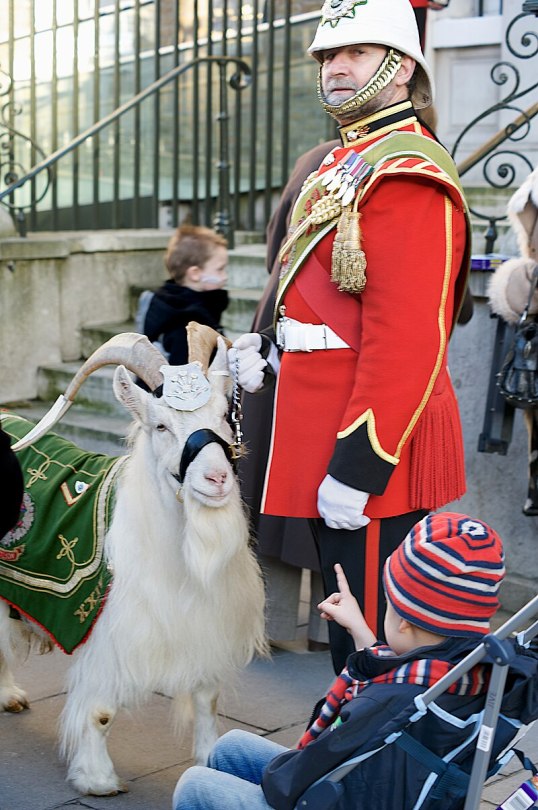#british army
Explore tagged Tumblr posts
Text

Pictured above: Brig. Gen. Anthony C. Mcauliffe, commander of the 101st Airborne Division, gives his various glider pilots last-minute instructions in England before the take-off on September 17, 1944 for Operation market Garden.
Today marks the 80th anniversary of Operation Market Garden. Its objective was to create a 64 mile salient into German territory with a bridgehead over the Nederrijn (Lower Rhine River), creating an Allied invasion route into northern Germany.
In the end, Market Garden was one of the costliest Allied failures of WWII, but remains a remarkable feat of arms. This is not because of its strategic ambition, but because of the determination and courage shown by Allied airborne troops and the units that tried to reach them.
It did however, lead to the liberation of a large part of the Netherlands at a time when many Dutch people were close to starvation.
(Photo courtesy of U.S. Air Force archives)
#operation market garden#market garden#wwii#world war 2#us army#101st airborne#paratroopers#82nd airborne#british army#british airborne#military#history#holland
98 notes
·
View notes
Text

British Comet tanks move through the streets of a devastated town - Germany, March 1944.
The Comet tanks were made in a Lancashire town called Leyland by Leyland motors. The number of employees went from under 500 in 1939 to over 3000 by 1944. Founded in 1896 and despite many ups and downs the company still manufactures today with around 1000 employees
#world war two#ww2#1940s#worldwar2photos#wwii#history#ww2 history#ww2history#1944#wwii era#world war 2#comet#tank#comet tank#Germany#british army#british leyland#Leyland motors#lancashire#Leyland
42 notes
·
View notes
Text
WW2: Real Footage
#ww2#colorized#video#wwii#second world war#world war 2#world war ii#world war two#world war#videos#war history#Germany#tumbler#tumblr#war#wars#photography#Europe#us marines#us army#german army#allies#soviet union#british army#soldiers#military#Army#western front#eastern front#history
570 notes
·
View notes
Text

British Army Apache operating in the Barton Stacey Training Area near Winchester
#Army Air Corps#British Army#BSTA#Boeing#AH-64#Apache#Army helicopter#attack helicopter#gunship#combat aircraft#military aviation
17 notes
·
View notes
Text

Troops of the British 3rd Infantry Division come ashore on Sword Beach, 0845 hours, 6 June 1944. They are led by the 84th Company of Royal Engineers. In the middle distance, medics tend to wounded men, while at the rear, commandos of the 1st Special Service Brigade disembark from landing craft. Photo credit: Sgt. J. Mapham/Imperial War Museum.
#history#military history#photography#historic photography#D-Day#Operation Overlord#Normandy landings#British Army#World War 2#black and white#b&w#b&w photography#Imperial War Museum
175 notes
·
View notes
Text
Royal Regiment of Fusiliers

17 notes
·
View notes
Text

Image: IWM (Q 10679) A staff officer of the 36th Division plays with a kitten outside his dug-out at Essigny, 7 February 1918. Ratchet noise maker and microphone for gas alarm nearby on the parapet.
123 notes
·
View notes
Text



The uniform of a senior French general, captured at the battle of Blenheim in 1704 and now forming part of the exhibition at the National Army Museum.
#history#british army#french army#military history#18th century#battle of blenheim#blenheim#duke of marlborough#marlborough#war of the spanish succession#louis ix
377 notes
·
View notes
Text

A British padre saying a prayer over a dying German, near Epehy - France, 18th September 1918.
#historical photos#the first world war#world war 1#world war one#1917#wwi#the great war#history#ww1#canadian history#france#great war#military history#british army#ww1 poetry#ww1 history#ww1 fiction#ww1 art
536 notes
·
View notes
Text

VE Day 80: The architect of victory; Winston Churchill. Without his constant warnings of the dangers to world peace in the 1930s, Britain would have been even more unprepared for war. A man at the right time, in the right place.
Seen here in Berlin, July, 1945 in the Uniform of the Oxfordshire Hussars of which he was now Honoury Colonel but had served as a active-duty soldier from 1902-24. (FTP)
29 notes
·
View notes
Text

British artillery officers used some interesting methods for locating German batteries.
How fucking bad were methods in 1916 that this is an improvement?
242 notes
·
View notes
Text

A drawing by Mary Evans, depicting New Zealand Soldiers climbing the walls of Le Quesnoy, during the Battle of the Sambre, part of the Hundred Day offensive, November 4, 1918
#history#ww1#anzac#new zealand#kiwi#first world war#world war one#world war 1#british army#great britain#great war#New Zealand army
295 notes
·
View notes
Text

Special Air Service (SAS) forces in North Africa, just back from a three month long range patrol, January 1943.
#ww2#british#army#sas#wwii#north africa#world war ii#second world war#world war 2#world war two#desert#war history#wars#world war#ii#world#war#2#photography#photo#tumblr#1940s#british army#Britain#soldiers#military#africa#wwi#ww1#history
336 notes
·
View notes
Text

British Sherman tanks of the 8th Armoured Division advance through the town of Kevelaer (Amsterdamer Straße), Germany, 4th March 1945
#world war two#ww2#1940s#worldwar2photos#history#wwii#ww2 history#ww2history#world war 2#wwii era#tank#british army#sherman#1945#cologne#Germany
132 notes
·
View notes
Text

#maus ⌐╦̵̵̿ᡁ᠊╾━#masked men#grunge#maus babbling#military#army#gunman#special forces#photography#woof#who knows which military this is#so i’ll tag them all#british military#military muscle#military jets#military men#german military#russian military#us military#us army#british army#gunfighter#hand guns#guns and ammo#gunfire#gunshot#machine gun#camo pants#us armed forces#maybe
55 notes
·
View notes
Text

Fusilier Windsor was charged with "unacceptable behaviour", "lack of decorum" and "disobeying a direct order." All information below from Wikipedia:
A Canadian animal rights group protested to the British Army, stating that he was merely "acting the goat", and should be reinstated. Three months later, on 20 September at the same parade ground, Billy regained his rank during the Alma Day parade which celebrates the Royal Welsh victory in the Crimean War. Captain Simon Clarke said, "Billy performed exceptionally well, he has had all summer to reflect on his behaviour at the Queen's birthday and clearly earned the rank he deserves".
Billy received his promotion from the colonel of the Royal Welsh Regiment, Brigadier Roderick Porter. As a result of regaining his rank, he also regained his membership of the corporals' mess.
Billy is not the first goat in the army to have troubles. At one time a royal goat was "prostituted" by being offered for stud services by the regiment's serving goat major to a Wrexham goat breeder. First charged with lèse-majesté, the goat major was ultimately court-martialled under the lesser charge of "disrespect to an officer" and reduced in rank. The goat major claimed he did it out of compassion for the goat, but this failed to impress the court. Another royal fusilier goat earned the nickname "the rebel", after he butted a colonel while he was stooped over fixing his uniform's trouser-strap. The incident was described as a "disgraceful act of insubordination.
At the time of posting, William "Billy" Windsor is honorably retired and residing in a Bedfordshire Zoo. He's outlived Queen Elizabeth II. So there's that.


Another regimental goat: Taffy IV, of the 2nd Battalion of the Welsh Regiment, was on active duty in France during World War I, participating in the Retreat from Mons, the First Battle of Ypres and other famous battles. He was awarded the 1914 Star.
#british army#military history#military mascots#goats#I mean that seems about right for a goat#cashmere goat#royal welsh fusiliers#wikipedia#animal facts#wwi#wwi history#the great war#meanwhile in wales#cymraeg#goat major being a rank is just tops
57 notes
·
View notes